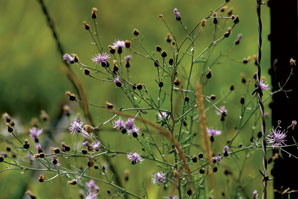As the summer weather begins to wane and most guests head home, a rather unwelcome visitor makes its presence known in the Flathead Valley. Knapweed is in full bloom, and officials say the valley is approaching the best time to attack them.
“It’s definitely that time of year,” Flathead County Weed Control and Parks and Recreation Director Jed Fisher said. “Most noxious weeds are going to seed right now.”
Montana currently lists 32 types of noxious weeds on its management control plan; these plants infest more than 7 million acres across the state, according to the Montana Weed Control Association. The state defines a noxious weed as “any exotic plant species that may render land unfit for agriculture, forestry, livestock, wildlife or other beneficial uses, or that may harm native plant communities.”
One of the most recognizable weeds is spotted knapweed, which has a pinkish-purple flower and brambly branches in full bloom. Knapweed is a tap-rooted species, which means it can adversely affect the water quality in areas it inhabits.
 |
|
The recognizable purple flowers are seen on a knapweed plant growing along Whitefish Stage Road. |
Fisher said the knapweed in Flathead County is no worse than previous years, but it can feel that way because of the high visibility right now.
“People should be able to tell if they’ve got them,” Fisher said. “It’s a mess right now.”
Patti Mason, outreach specialist for the Flathead County Conservation District, said the early summer rain probably helped the knapweed flourish as much as it did any other plant.
“This is when you really become aware of how much there is,” Mason said.
There are many levels in the war on noxious weeds, ranging from individual landowners to county efforts to statewide initiatives aimed at the foreign plants. In the valley, Fisher said Flathead County spends $500,000 annually to combat the weeds on about 4,000 acres through various means.
The county weed control management plan includes spraying herbicide, mowing county right of ways and using insects to fight the plants, Fisher said. The mechanical, chemical and biological approach puts Flathead County ahead of other counties when it comes to acreage rid of the plants, Fisher said.
“We’re the best,” Fisher said. “If one takes a look a Flathead County in comparison to Lincoln County and Missoula County, it’s quite impressive.”
Fisher noted that Glacier National Park and the U.S. Forest Service are also dedicated to eradicating the weeds, which helps the county’s efforts significantly.
But both Fisher and Mason say there is never any time to rest when it comes to noxious weeds. The county continues to expand its management plans, Fisher said, but there are new patches of knapweed every year.
The county is building a mapping system to help keep track of the various noxious plants within its borders, Fisher said, which costs about $30,000.
Landowners should use the late summer weed visibility as motivation to cut them on their land, Mason said.
“At this point, the best thing that people can do is cut it and bag it up and send it to the landfill,” Mason said.
Taking the plants to the landfill is key, she said, because the plants can still produce viable seeds even after they’ve been mowed down.
Flathead Valley residents should also start thinking about spraying knapweed patches as the plant approaches its most vulnerable time of the year. As the plants begin preparing for winter by storing food preserves in the roots, herbicides can move deeply and sit in the roots as well.
“Fall is a very good time to spray, after the first hard frost,” Mason said. “Try to knock it down for next year.”
Landowners can also fight the plants by beginning removal from the outside of a knapweed patch and working their way in. This proves to be more effective than working inside out, Mason said.
She also said any new “hot spots” in the yard – plants that have never been there before – should be removed before it can spread.
There are also weed control options that do not involve chemical herbicides, Mason said.
Fisher said landowners can call county weed control for help identifying plants and setting up a management plan. This service is usually directed at owners with large acreage, but people with questions about plants in their yards can call as well, he said.
The more people who help fight the noxious plants the better, Fisher and Mason said.
“There’s a lot of weeds, it takes a lot of people who know what they’re looking for,” Fisher said. “It takes a small army.”
To contact Flathead County Weed Control District, call 758-5798 or visit http://flathead.mt.gov/weeds/. For more information on noxious weeds and control options, visit www.mtweed.org.